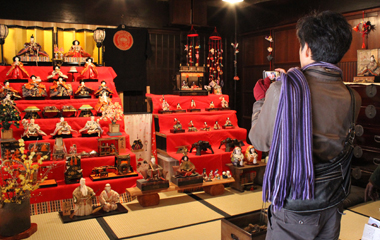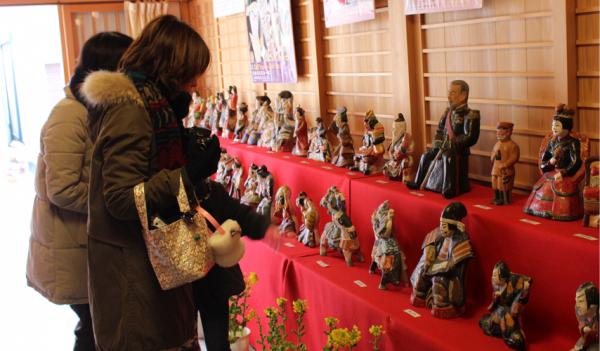
Chuma Hina Dolls are traditional Hina dolls on display in the households and shops along Asuke's historic townscape. What sets the dolls apart is the way they are displayed in the entries and foyers of those houses and establishments for all to see. As a stop along the historic Chuma Kaido Road, connecting the Mikawa Bay to the more mountainous regions in the north, Asuke has always been a destination for travelers, and this custom began as a means to entertain travelers as they walked through the town and continues to be a big event in the area.

You may see of hear the phrase "Chuma" around Asuke. During the Edo period, people made livings transporting freight on horseback. "Chuma" began as the name for the union couriers', and then became the general way to refer to the actual people hauling goods to and fro along the Ina Kaido Road (also known as the Ida Kaido Road).
As so many Chuma transporters used the road, it came to be referred to as the Chuma Kaido, or Chuma Road. Asuke was located midway through the Chuma Kaido Road, and thanks to the Chuma couriers, the important commodity of salt created in the Mikawa Bay was able to be carried into the mountains of Nagano while mountain crops like rice and tobacco grown there could be brought down to the bay area.
Gando
The custom of "Gando" has lived on in Asuke since antiquity. On the day of the Hina Doll Festival, children go to different houses in their neighborhood asking to see that household's Hina dolls. Not only do the children get to see the beautiful dolls but they also receive Japanese confections. The Japanese confectioneries below stay true to the custom and offer sweets.
Date: Sat, Feb 10, 2024
Applicable ages: Elementary school ages and younger (on a first-come, first-served basis for the first 100 children to come to the shops below)
Participating shops: Fugai, Ryoguchiya, Katoya, Kawamuraya
Shin-Ta-machi Gando
Receive a coupon at the Shin-Ta-machi Town Community Center and submit it at the Suzuman Hompo shop for a treat (coupon valid the day it is received only).
Dates and time: From 10:00 am on Sun, Feb 11; Sun, Feb 18; Sun, Feb 25; Sun, Mar 3; and Sun, Mar 10, 2024
Applicable ages: Elementary school ages and younger (up to 50 children each day)
Earthenware Hina doll painting demonstration and experience
Paint your own animal doll with acrylic paints as you watch Mikawa Ohama earthenware doll artist Mr. Negita work his magic before your eyes.
Preschool children must be accompanied by a guardian. Approximately half an hour to one hour is required.
Dates: Sat, Feb 17; Sun, Feb 18; Sat, Feb 24; Sun, Feb 25; Sat, Mar 2; Sun, Mar 3; Sat, Mar 9; and Sun, Mar 10, 2024
Demonstration time: 10:00 am–4:00 pm (various times)
Experience time: 10:00 am–3:00 pm (Reception until 2:30 pm. No reservation required.)
Price: JPY 1,000/doll
Location: Former Taguchi Residence (near the Hon-machi Town Community Center)
Note:
• Select the doll you will paint from an assortment of animals (Hina dolls not available).
Chuma doll treasure hunt
Shop, eat, and collect stamps at shops along the Asuke shopping street participating in the treasure hunt for an original Hina doll pin present (available to 30 participants on weekdays and 50 participants on weekends on a first-come, first-served basis).
Date: Every day throughout the event period
Taiko Drum Festival
Feel the thundering rhythms of traditional Japanese taiko drums through your entire body!
Date and time: Sun, Feb 11, 2024 (canceled should rainy weather occur)
Location: Asuke Jinja Plaza
First session: From 11:00 (Sanshu Asuke Taiko Troupe)
Second session: From 1:00 pm (Jinnaka Taiko Troupe)





















 Keyword
Keyword









